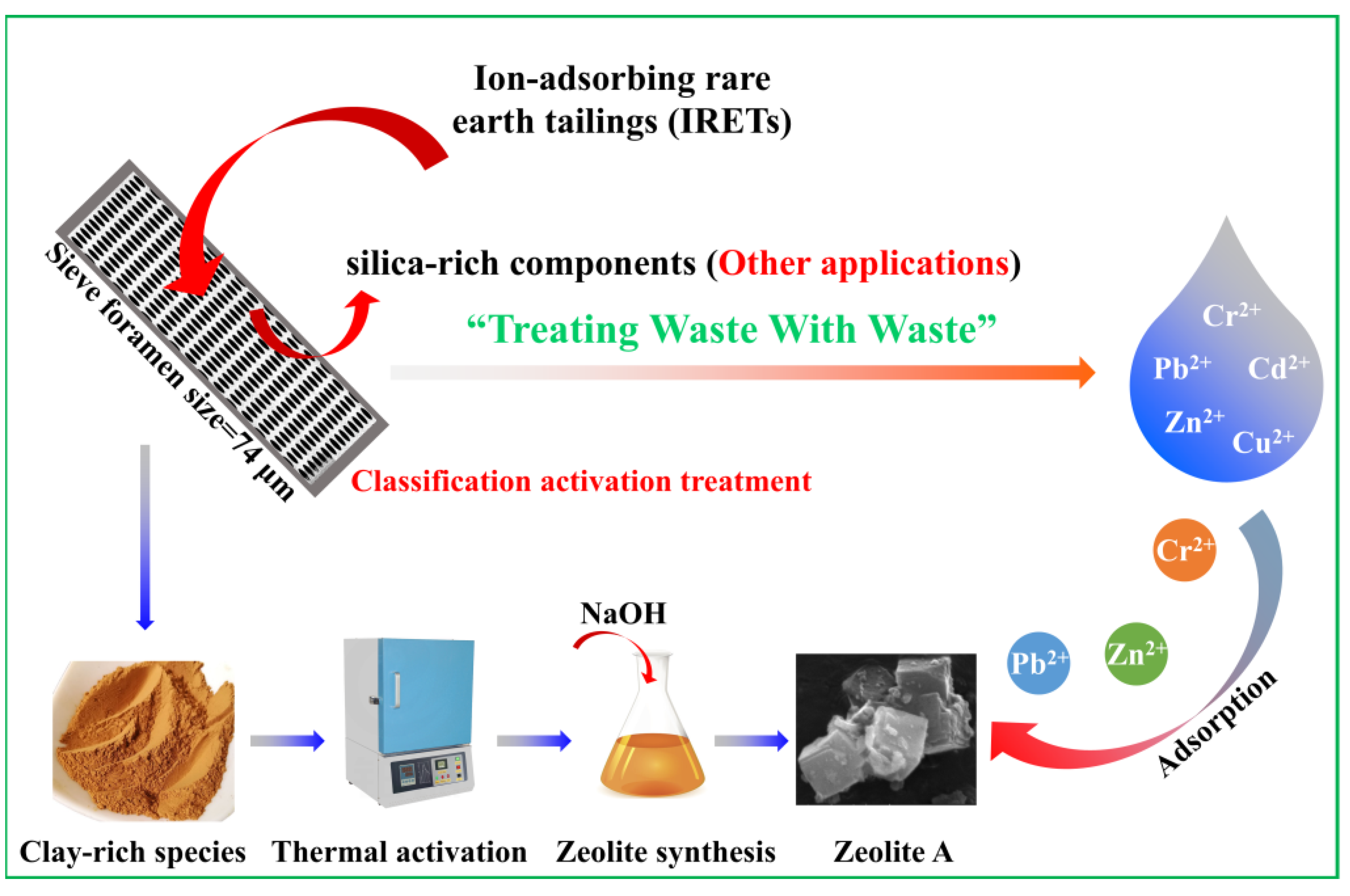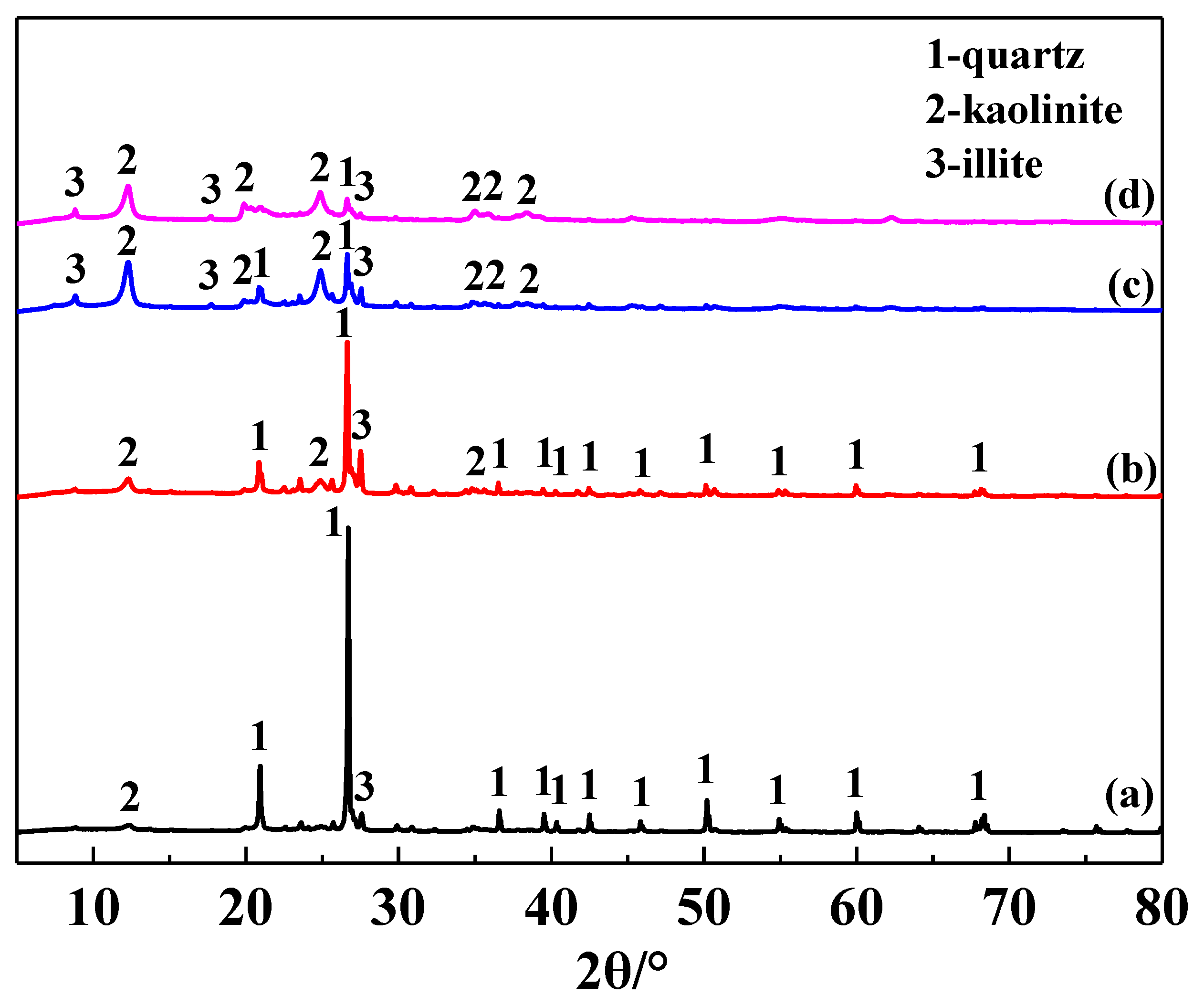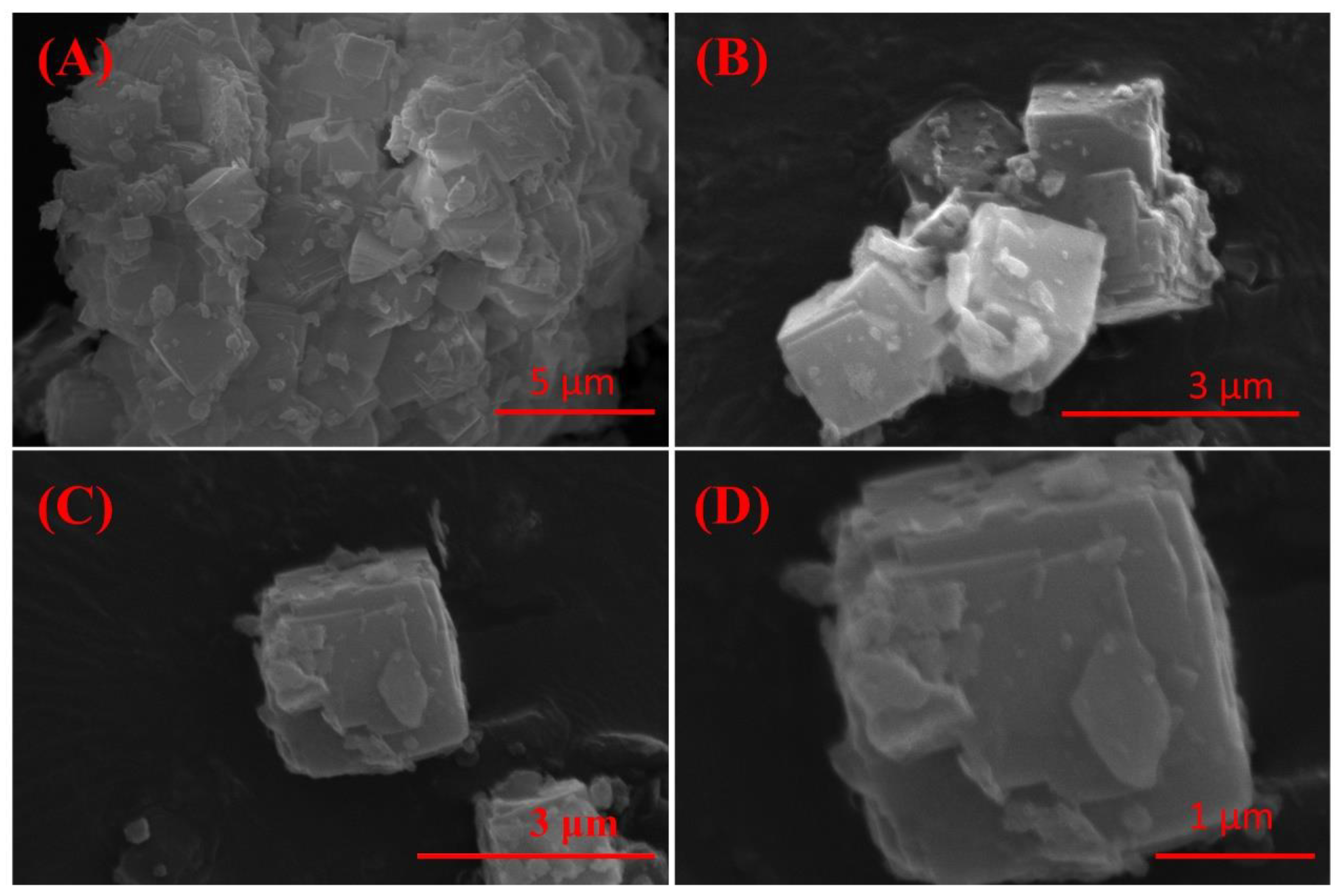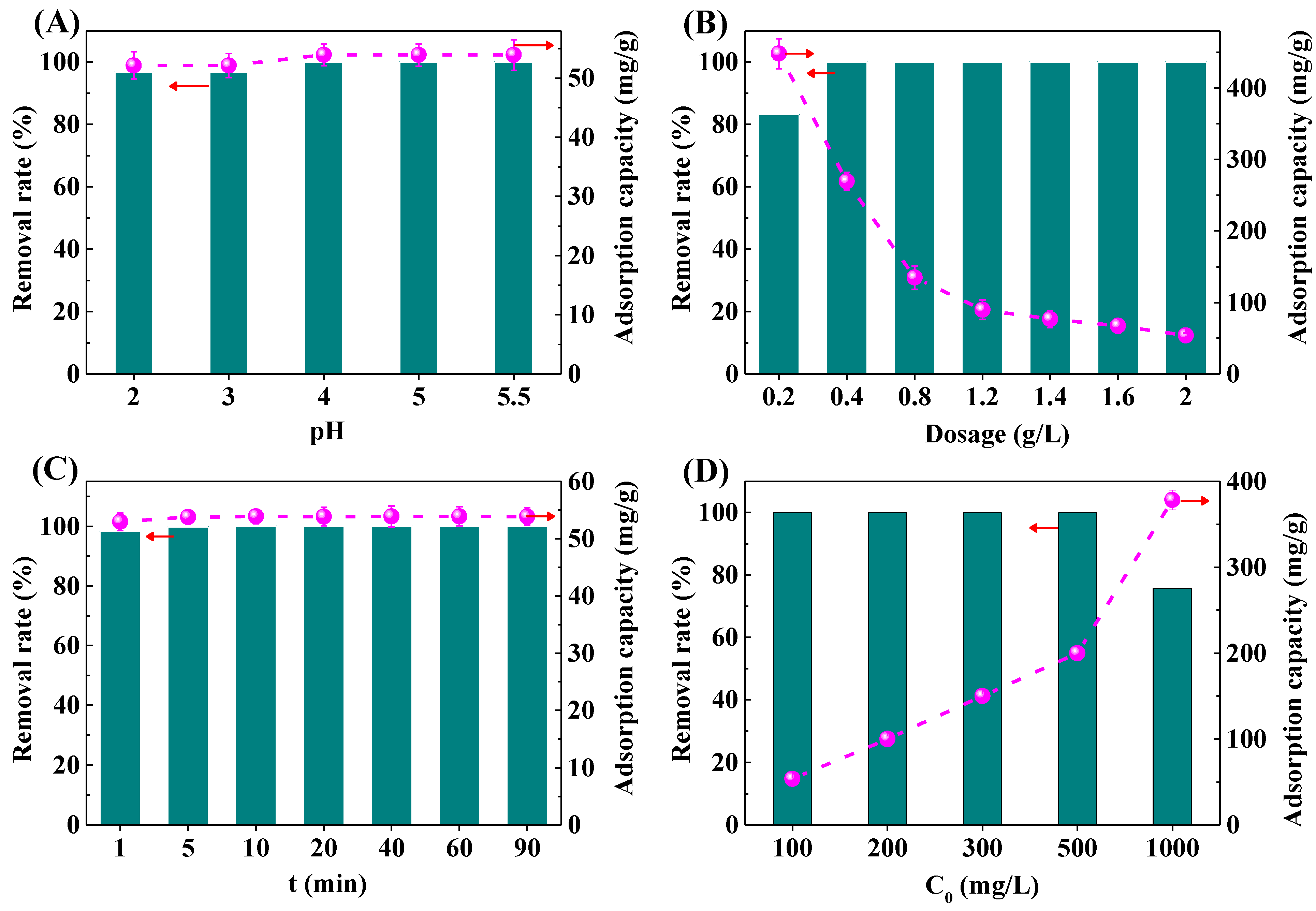Preparation of Zeolite A from Ion-Adsorbing Rare Earth Tailings for Selective Adsorption of Pb2+: An Innovative Approach to Waste Valorization
Abstract
1. Introduction
2. Results and Discussion
2.1. Particle Size Distribution and Composition of IRETs
2.2. Effect of Crystallization Conditions on the Phase of IRET-ZEO
2.3. Effect of Factors on Adsorptive Properties of Synthesized Zeolite
2.4. Adsorption Kinetics
2.5. Selective and Regeneration Adsorption
3. Materials and Methods
3.1. Materials
3.2. Activation of Tailings and Zeolite Crystallization
3.3. Adsorption Experiments
- η: Removal efficiency (%);
- C0: Initial concentration of Pb2+ (mg/L);
- Ct: Concentration of Pb2+ present in solution after adsorption time t (mg/L);
- Ce: Concentration of Pb2+ remaining in solution at adsorption equilibrium (mg/L);
- q: Adsorption capacity (mg/g);
- V: Volume of solution used in the adsorption experiment (L);
- m: Mass of adsorbent material used (g).
3.4. Adsorption Kinetics
- t: Adsorption time (min);
- k1: Adsorption rate constant obtained from the pseudo-first-order kinetic model (min−1);
- k2: Adsorption rate constant obtained from the pseudo-second-order kinetic model (g·mg−1·min−1);
- qe: Adsorption capacity at equilibrium (mg·g−1);
- qt: Adsorption capacity at time t (mg·g−1);
- α: Elovich coefficient (mg·g−1·min−1);
- β: Elovich coefficient (g·mg−1);
- ki: Adsorption rate constant obtained from the intraparticle diffusion model (mg·g−1·min−1/2);
- C: Constant (mg·g−1).
3.5. Selective Adsorption Experiments
3.6. Regeneration Adsorption Experiment
3.7. Characterization Methods
3.7.1. X-Ray Diffraction Analysis (XRD)
3.7.2. Scanning Electron Microscope (SEM)
3.7.3. Inductively Coupled Plasma Emission Spectrometer (ICP-OES)
3.7.4. X-Ray Fluorescence Spectrometer (XRF)
4. Conclusions
- (1)
- The primary mineral phases of the IRETs are kaolinite, quartz, and illite. The tailings contain 61.60% SiO2 and 24.86% Al2O3, with lower concentrations of other impurities. IRETs are a potential source of silica–aluminum for zeolite preparation. The clay minerals used in this study were primarily concentrated in particles smaller than 0.074 mm, and the clay-rich components could be easily separated by sieving. However, further work is required to explore the resource utilization of the coarse, silica-rich components.
- (2)
- Based on a phase analysis of the crystallization products, the optimal conditions for synthesizing the IRET-ZEO from the tailings through alkali dissolution were identified. The optimal activation parameter was calcination at 850 °C for 1 h. The optimal crystallization parameters were a NaOH concentration of 5 mol/L, a crystallization time of 3 h, and a crystallization temperature of 85 °C. The synthesized product was cubic A-type zeolite.
- (3)
- In acidic solutions with a pH range of 2 to 5.5 and an initial Pb2+ concentration of 100 mg/L, the removal rate of Pb2+ by the IRET-ZEO remained consistently above 96.7%. Notably, when the solution pH exceeded 4.2, the Pb2+ removal rate reached 100%. This demonstrated that the IRET-ZEO exhibited a fast adsorption rate (reaching equilibrium within 5 min), a high adsorption capacity (378.35 mg/g), and excellent acid resistance, selectivity, and regeneration performance. The adsorption kinetics results indicated that the adsorption of Pb2+ by the IRET-ZEO follows a pseudo-second-order kinetic model, with the process being primarily governed by chemical interactions. This work provides a new strategy for the resource and valorization utilization of IRETs with “treating waste with waste” applications.
Author Contributions
Funding
Institutional Review Board Statement
Informed Consent Statement
Data Availability Statement
Acknowledgments
Conflicts of Interest
References
- Italiya, G.; Ahmed, M.H.; Subramanian, S. Titanium oxide bonded Zeolite and Bentonite composites for adsorptive removal of phosphate. Environ. Nanotechnol. Monit. Manag. 2022, 17, 100649. [Google Scholar] [CrossRef]
- Vardhan, K.H.; Kumar, P.S.; Panda, R.C. A review on heavy metal pollution, toxicity and remedial measures: Current trends and future perspectives. J. Mol. Liq. 2019, 290, 111197. [Google Scholar] [CrossRef]
- Yang, X.; Liu, L.H.; Wang, Y.; Lu, T.; Wang, Z.W.; Qiu, G.H. Sustainable and reagent-free cathodic precipitation for high-efficiency removal of heavy metals from soil leachate. Environ. Pollut. 2023, 320, 121002. [Google Scholar] [CrossRef] [PubMed]
- Lin, H.; Zhou, M.Y.; Li, B.; Dong, Y.B. Mechanisms, application advances and future perspectives of microbial-induced heavy metal precipitation: A review. Int. Biodeter. Biodegr. 2023, 178, 105544. [Google Scholar] [CrossRef]
- Fei, Y.H.; Hu, H.Y. Recent progress in removal of heavy metals from wastewater: A comprehensive review. Chemosphere 2023, 335, 139077. [Google Scholar] [CrossRef]
- Liu, Y.; Fu, R.Q.; Sun, Y.; Zhou, X.X.; Baig, S.A.; Xu, X.H. Multifunctional nanocomposites Fe3O4@SiO2-EDTA for Pb(II) and Cu(II) removal from aqueous solutions. Appl. Surf. Sci. 2016, 369, 267–276. [Google Scholar] [CrossRef]
- Parry, D.; Jabez, W.O.; Kirubhadharsini, B.L. An insight on the plausible biological and non-biological detoxification of heavy metals in tannery waste: A comprehensive review. Environ. Res. 2024, 258, 119451. [Google Scholar]
- Cao, Y.Y.; Xiao, W.H.; Shen, G.H.; Ji, G.Y.; Zhang, Y.; Gao, C.F.; Han, L.J. Carbonization and ball milling on the enhancement of Pb(II) adsorption by wheat straw: Competitive effects of ion exchange and precipitation. Bioresour. Technol. 2019, 273, 70–76. [Google Scholar] [CrossRef]
- Oberta, A.; Wasilewski, J.; Wódzki, R. Structure and transport properties of polymer inclusion membranes for Pb(II) separation. Desalination 2011, 271, 132–138. [Google Scholar] [CrossRef]
- Liang, B.; Zhu, P.; Gu, J.; Yuan, W.; Xiao, B.; Hu, H.; Rao, M. Advancing Adsorption and Separation with Modified SBA-15: A Comprehensive Review and Future Perspectives. Molecules 2024, 29, 3543. [Google Scholar] [CrossRef]
- Peng, Y.; Zhu, P.; Zou, Y.; Gao, Q.; Xiong, S.; Liang, B.; Xiao, B. Overview of Functionalized Porous Materials for Rare-Earth Element Separation and Recovery. Molecules 2024, 29, 2824. [Google Scholar] [CrossRef] [PubMed]
- Liang, B.; Hu, H.; Xiao, B.; Lu, Z.; Yuan, W.; Huang, Z. Water Leaching Kinetics of Boron from the Alkali-Activated Ludwigite Ore. Molecules 2024, 29, 826. [Google Scholar] [CrossRef] [PubMed]
- Liang, B.; Gu, J.; Zeng, X.; Yuan, W.; Rao, M.; Xiao, B.; Hu, H. A Review of the Occurrence and Recovery of Rare Earth Elements from Electronic Waste. Molecules 2024, 29, 4624. [Google Scholar] [CrossRef] [PubMed]
- Maghfirah, A.; Ilmi, M.M.; Fajar, A.T.N.; Kadja, G.T.M. A review on the green synthesis of hierarchically porous zeolite. Mat. Today Chem. 2020, 17, 100348. [Google Scholar] [CrossRef]
- Yoldi, M.; Fuentes-Ordoñez, E.G.; Korili, S.A.; Gil, A. Zeolite synthesis from industrial wastes. Micropor. Mesopor. Mat. 2019, 287, 183–191. [Google Scholar] [CrossRef]
- Abbadi, A.; Mucsi, G. A review on complex utilization of mine tailings: Recovery of rare earth elements and residue valorization. J. Environ. Chem. Eng. 2024, 12, 113118. [Google Scholar] [CrossRef]
- Han, C.Y.; Yang, J.; Dong, S.L.; Ma, L.Q.; Dai, Q.X.; Guo, J.Y. Zeolite preparation from industrial solid waste: Current status, applications, and prospects. Sep. Purif. Technol. 2025, 354, 128957. [Google Scholar] [CrossRef]
- Flores, C.G.; Schneider, H.; Dornelles, J.S.; Gomes, L.B.; Marcilio, N.R.; Melo, P.J. Synthesis of potassium zeolite from rice husk ash as a silicon source. Clean. Eng. Technol. 2021, 4, 100201. [Google Scholar] [CrossRef]
- Cao, C.Y.; Xuan, W.W.; Yan, S.Y.; Wang, Q. Zeolites synthesized from industrial and agricultural solid waste and their applications: A review. J. Environ. Chem. Eng. 2023, 11, 110898. [Google Scholar] [CrossRef]
- Li, W.L.; Jin, H.X.; Xie, H.Y.; Ma, L.R. Utilization of electrolytic manganese residue and bauxite to synthesize zeolite a for pickle liquor adsorption: Characterization, mechanisms and performance. J. Clean. Prod. 2023, 429, 139537. [Google Scholar] [CrossRef]
- Valbuena, H.M.G.; Medinaa, A.F.; Vargasa, J.C.; Fandiño, O.H. Synthesis of zeolites Na-A, Na-X, and analcime from crushed stone waste and their applications in heavy metal removal in aqueous media. Chem. Eng. Res. Des. 2023, 197, 159–172. [Google Scholar] [CrossRef]
- Sayehi, M.; Delahay, G.; Tounsi, H. Synthesis and characterization of ecofriendly materials zeolite from waste glass and aluminum scraps using the hydrothermal technique. J. Environ. Chem. Eng. 2022, 10, 108561. [Google Scholar] [CrossRef]
- Lin, Y.J.; Chen, J. Resourcization and valorization of waste incineration fly ash for the synthesis of zeolite and applications. J. Environ. Chem. Eng. 2021, 9, 106549. [Google Scholar] [CrossRef]
- Lee, W.H.; Lin, Y.W.; Lin, K.L. Optimization of synthesis parameters for the preparation of zeolite by reusing industrialwaste as raw material: Sandblasting waste and solar panel waste glass. Solid State Sci. 2023, 143, 107277. [Google Scholar] [CrossRef]
- Lv, Y.W.; Ma, B.Z.; Liu, Y.B.; Wang, C.Y.; Chen, Y.Q. Adsorption behavior and mechanism of mixed heavy metal ions by zeolite adsorbent prepared from lithium leach residue. Micropor. Mesopor. Mat. 2022, 329, 111553. [Google Scholar] [CrossRef]
- Indira, V.; Abhitha, K. A review on recent developments in Zeolite A synthesis for improved carbon dioxide capture: Implications for the water-energy nexus. Energy Nexus 2022, 7, 100095. [Google Scholar] [CrossRef]
- Gao, S.; Peng, H.; Song, B.; Zhang, J.X.; Wu, W.X.; Vaughan, J.; Zardo, P.; Vogrin, J.; Tulloch, S.; Zhu, Z.H. Synthesis of zeolites from low-cost feeds and its sustainable environmental applications. J. Environ. Chem. Eng. 2023, 11, 108995. [Google Scholar] [CrossRef]
- Qiang, Z.Q.; Shen, X.J.; Guo, M.; Cheng, F.Q.; Zhang, M. A simple hydrothermal synthesis of zeolite X from bauxite tailings for highly efficient adsorbing CO2 at room temperature. Micropor. Mesopor. Mat. 2019, 287, 77–84. [Google Scholar] [CrossRef]
- Li, J.F.; Xiao, Y.F.; Feng, X.J.; Wang, J.; Ma, Z.Y.; Yao, R.F.; Zhai, Y.Q.; Tian, L. Leaching of ion adsorption rare earths and the role of bioleaching in the process: A review. J. Clean. Prod. 2024, 468, 143067. [Google Scholar] [CrossRef]
- Zhou, F.; Zhang, Y.X.; Liu, Q.; Huang, S.H.; Wu, X.Y.; Wang, Z.W.; Zhang, L.S.; Chi, R. Modified tailings of weathered crust elution-deposited rare earth ores as adsorbents for recovery of rare earth ions from solutions: Kinetics and thermodynamics studies. Miner. Eng. 2023, 191, 107937. [Google Scholar] [CrossRef]
- He, Q.; Chen, J.F.; Gan, L.M.; Gao, M.L.; Zan, M.M.; Xiao, Y.F. Insight into leaching of rare earth and aluminum from ion adsorption type rare earth ore: Adsorption and desorption. J. Rare Earth. 2023, 41, 1398–1407. [Google Scholar] [CrossRef]
- Yang, Y.J.; Zhang, M.Q.; Feng, L.; Huang, B.; Zhai, R.Y.; Sun, X.Q. Sustainable reutilization of ion-adsorbed rare earth tailings: Preparation of low-cost functionalized pigments. Ceram. Int. 2024, 50, 11575–11587. [Google Scholar] [CrossRef]
- Cheng, J.C.; Hua, X.L.; Zhang, G.H.; Yu, M.Q.; Wang, Z.; Zhang, Y.L.; Liu, W.; Chen, Y.J.; Wang, H.M.; Luo, Y.D.; et al. Synthesis of high-crystallinity Zeolite A from rare earth tailings: Investigating adsorption performance on typical pollutants in rare earth mines. J. Hazard. Mater. 2024, 468, 133730. [Google Scholar] [CrossRef] [PubMed]
- Ismail, U.M.; Vohra, M.S.; Onaizi, S.A. Adsorptive removal of heavy metals from aqueous solutions: Progress of adsorbents development and their effectiveness. Environ. Res. 2024, 251, 118562. [Google Scholar] [CrossRef] [PubMed]
- Şenol, Z.N.M.; Elma, E.; Messaoudi, N.E.; Mehmeti, V. Performance of cross-linked chitosan-zeolite composite adsorbent for removal of Pb2+ ions from aqueous solutions: Experimental and Monte Carlo simulations studies. J. Mol. Liq. 2023, 391, 123310. [Google Scholar] [CrossRef]
- Ma, W.Q.; Yi, Y.R.; Fang, M.H.; Lin, Y.; Li, C.H.; Li, J.; Liu, W. Zeolite prepared from high-calcium ladle furnace slag and fly ash for Pb2+ removal. J. Water Process Eng. 2024, 61, 105351. [Google Scholar] [CrossRef]
- Cui, K.B.; Lyu, J.W.; Liu, H.Z.; Yang, J.L.; Yan, Z.Q.; Yang, W.; Liu, X.; Qiu, J. Eco-friendly synthesis of magnetic zeolite A from red mud and coal gasifcation slag for the removal of Pb2+ and Cu2+. J. Environ. Chem. Eng. 2024, 12, 113739. [Google Scholar] [CrossRef]
- Shichalin, O.O.; Papynov, E.K.; Ivanov, N.P.; Balanov, M.I.; Dran’kov, A.N.; Shkuratov, A.L.; Zarubina, N.V.; Fedorets, A.N.; Mayorov, V.Y.; Lembikov, A.O.; et al. Study of adsorption and immobilization of Cs+, Sr2+, Co2+, Pb2+, La3+ ions on Na-Faujasite zeolite transformed in solid state matrices. Sep. Purif. Technol. 2024, 332, 125662. [Google Scholar] [CrossRef]
- Cheng, T.W.; Lee, M.L.; Ko, M.S.; Ueng, T.H.; Yang, S.F. The heavy metal adsorption characteristics on metakaolin-based geopolymer. Appl. Clay Sci. 2012, 56, 90–96. [Google Scholar] [CrossRef]
- Drweesh, S.A.; Fathy, N.A.; Wahba, M.A.; Hanna, A.A.; Akarish, A.I.M.; Elzahany, E.A.M.; El-Sherif, I.Y.; Abou-El-Sherbini, K.S. Equilibrium, kinetic and thermodynamic studies of Pb(II) adsorption from aqueous solutions on HCl-treated Egyptian kaolin. J. Environ. Chem. Eng. 2016, 4, 1674–1684. [Google Scholar] [CrossRef]
- Gao, S.; Liu, Y.H. Potassium-assisted synthesis of SUZ-4 zeolite as an efficient adsorbent for Pb2+ removal from wastewater. Sep. Purif. Technol. 2022, 286, 120438. [Google Scholar] [CrossRef]
- Yuan, W.Q.; Kuang, J.Z.; Yu, M.M.; Huang, Z.Y.; Zou, Z.L.; Zhu, L.P. Facile preparation of MoS2@Kaolin composite by one-step hydrothermal method for efficient removal of Pb(II). J. Hazard. Mater. 2021, 405, 124261. [Google Scholar] [CrossRef]
- Yuan, W.Q.; Kuang, J.Z.; Yu, M.M.; Huang, Z.Y.; Wang, X.Y.; Xiao, J.J.; Zhang, S.Y.; Cheng, H.; Yang, Y.Q. Facile synthesis and characterization of ZnS polymorphs/Halloysite composite for efficiently selective adsorption of Al(III) from acidic rare earth ions solution. Sep. Purif. Technol. 2022, 291, 120849. [Google Scholar] [CrossRef]
- Yuan, W.Q.; Kuang, J.Z.; Hu, H.X.; Ding, D.; Yu, M.M. Preparation of chitosan mesoporous membrane/halloysite composite for efficiently selective adsorption of Al(III) from rare earth ions solution through constructing pore structure on substrate. Int. J. Biol. Macromol. 2024, 256, 128351. [Google Scholar] [CrossRef] [PubMed]
- Ho, Y.S.; McKay, G. Comparative sorption kinetic studies of dye and aromatic compounds onto fly ash. J. Environ. Sci. Health Part A 1999, 34, 1179–1204. [Google Scholar] [CrossRef]
- Ho, Y.S.; McKay, G. Pseudo-second order model for sorption processes. Process Biochem. 1999, 34, 451–465. [Google Scholar] [CrossRef]
- Bhattacharyya, K.G.; Gupta, S.S. Pb(II) uptake by kaolinite and montmorillonite in aqueous medium: Influence of acid activation of the clays. Colloid. Surface A 2006, 277, 191–200. [Google Scholar] [CrossRef]
- Gong, F.Z.; Cai, H.M.; Zhou, B.; Ou, H.L. The synthesis and characterization of AlPO4 hollow microspheres of uniform size, and the sorption properties for Pb2+, Cd2+, Cu2+, and Zn2+. Colloid. Surface A 2018, 554, 286–295. [Google Scholar] [CrossRef]









| SiO2 | Al2O3 | MgO | CaO | K2O | Na2O | Fe2O3 | SO3 | Rb2O | Y2O3 | LOI |
|---|---|---|---|---|---|---|---|---|---|---|
| 61.60 | 24.86 | 0.32 | 0.09 | 4.41 | 0.39 | 1.95 | 0.21 | 0.10 | 0.05 | 6.02 |
| Particle Size/mm | Mass/g | Distribution Ratio/% |
|---|---|---|
| >0.8 | 114.00 | 57.00 |
| 0.074~0.8 | 48.12 | 24.09 |
| 0.044~0.074 | 4.88 | 2.44 |
| <0.044 | 32.94 | 16.47 |
| Total | 200.00 | 100.00 |
| Adsorbents | pH | Dosage (g/L) | Adsorption Equilibrium Time (min) | Maximum Adsorption Capacity (mg/g) | References |
|---|---|---|---|---|---|
| Chitosan–zeolite | 4.5 | 5 | 1440 | 275 | [35] |
| LFS + FA | 5 | 1 | 180 | 292.8 | [36] |
| MZA | 4~5 | - | 120 | 330.72 | [37] |
| Zeolite NaY | 6 | 1 | 2880 | 527.12 | [38] |
| Metakaolin-based geopolymer | 4.0 | - | 147.06 | [39] | |
| HCl-treated Egyptian kaolin | 5.5 | - | 90 | 34.5 | [40] |
| Na-T13 | 8 | 0.2 | 5 | 170.12 | [41] |
| MoS2@kaolin | 2~5.5 | 1.6 | 40 | 280.39 | [42] |
| IRET-ZEO | 2~5.5 | 0.4 | 5 | 378.35 | This work |
| Models | Kinetic Parameters | ||
|---|---|---|---|
| Pseudo-first-order kinetic model | k1 (min−1) 0.0267 | qe (mg·g−1) 0.18 | R2 0.2393 |
| Pseudo-second-order kinetic model | k2 (g·mg−1·min−1) 1.1532 | qe (mg·g−1) 53.76 | R2 0.9999 |
| Intraparticle diffusion model | ki (mg·g−1·min−1/2) 0.6634 | C (mg·g−1) 52.28 | R2 1.0000 |
| 0.0116 | 53.79 | 0.5734 | |
| Elovich equation | α (mg·g−1·min−1) - | β (mg·g−1) 0.18 | R2 0.6067 |
Disclaimer/Publisher’s Note: The statements, opinions and data contained in all publications are solely those of the individual author(s) and contributor(s) and not of MDPI and/or the editor(s). MDPI and/or the editor(s) disclaim responsibility for any injury to people or property resulting from any ideas, methods, instructions or products referred to in the content. |
© 2024 by the authors. Licensee MDPI, Basel, Switzerland. This article is an open access article distributed under the terms and conditions of the Creative Commons Attribution (CC BY) license (https://creativecommons.org/licenses/by/4.0/).
Share and Cite
Huang, Q.; Wang, W.; Lai, W.; Liang, B.; Xiao, B.; Gu, J.; Huang, Z.; Zeng, X.; Liu, H.; Hu, H.; et al. Preparation of Zeolite A from Ion-Adsorbing Rare Earth Tailings for Selective Adsorption of Pb2+: An Innovative Approach to Waste Valorization. Molecules 2024, 29, 5065. https://doi.org/10.3390/molecules29215065
Huang Q, Wang W, Lai W, Liang B, Xiao B, Gu J, Huang Z, Zeng X, Liu H, Hu H, et al. Preparation of Zeolite A from Ion-Adsorbing Rare Earth Tailings for Selective Adsorption of Pb2+: An Innovative Approach to Waste Valorization. Molecules. 2024; 29(21):5065. https://doi.org/10.3390/molecules29215065
Chicago/Turabian StyleHuang, Qiangwei, Wenbo Wang, Wenhui Lai, Binjun Liang, Bin Xiao, Jihan Gu, Zheyu Huang, Xiangrong Zeng, Hui Liu, Haixiang Hu, and et al. 2024. "Preparation of Zeolite A from Ion-Adsorbing Rare Earth Tailings for Selective Adsorption of Pb2+: An Innovative Approach to Waste Valorization" Molecules 29, no. 21: 5065. https://doi.org/10.3390/molecules29215065
APA StyleHuang, Q., Wang, W., Lai, W., Liang, B., Xiao, B., Gu, J., Huang, Z., Zeng, X., Liu, H., Hu, H., & Yuan, W. (2024). Preparation of Zeolite A from Ion-Adsorbing Rare Earth Tailings for Selective Adsorption of Pb2+: An Innovative Approach to Waste Valorization. Molecules, 29(21), 5065. https://doi.org/10.3390/molecules29215065






